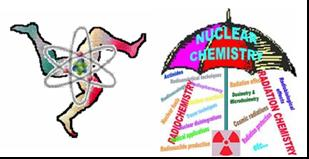Speaker
Dr
Stanislav Pavelka
(Institute of Physiology, ASCR, Prague/Central-European Technology Institute, Masaryk University, Brno, Czech Republic)
Description
With the aid of several radioanalytical methods, we studied the effects of an enhanced bromide and/or perchlorate intake on various aspects of iodine metabolism and, consequently, on the metabolism of thyroid hormones in the rat. Presumed goitrogenic and thyrotoxic effects of excessive bromide and perchlorate ions were followed in adult male rats, as well as in lactating rat dams (and their breast-fed pups), maintained on diets with different iodine content, ensuring either sufficient iodine supply or mild to severe iodine deficiency. The animals were administered subchronicaly (for 7 to 56 days) with bromide alone (in drinking water) or in combination with perchlorate.
At the whole-organism level, we followed the influence of exogenous bromide on the uptake of [131I]-iodide by the thyroids and by various others organs and tissues (especially the mammary glands), as well as on the kinetics of elimination of iodine from the animal’s body. Bromide was applied in very low (ca. 0.2 mg) up to extremely high doses (> 200 mg bromide per animal per day). Especially, we followed the effects of high bromide levels in the organism of lactating rat dams on their performance in the course of nursing period and on the prosperity of their breast-fed pups.
In rats administered with bromide and perchlorate we measured a consistent increase in relative weight of the thyroids with increasing time and concentration of applied bromide, and a sharp reduction of the 24-h uptake of [131I]-iodide by their thyroids. In these animals, we also determined (with radioimmunoassay using [125I]-thyroxine as radiotracer) a steady decline in serum total thyroxine concentration. Moreover, excessive bromide in the mothers substantially depressed the extent of [131I]-iodine transfer from the dams through mother’s milk to the suckling. As a consequence, a marked decline in the body weight increments of afflicted pups, in comparison with the young from mothers kept on a low bromide intake was observed. We have also confirmed the earlier observation that bromide toxicity is dependent on the state of iodine supply into the organism. Hypothyroidism in experimental animals caused by excessive bromide intake was more pronounced under the conditions of iodine deficiency (i.e., in animals maintained on a low-iodine diet). Very high bromide levels in the organism of the mothers adversely affected also the thyroids of their young.
At the molecular level, we studied the effects of exogenous bromide and perchlorate ions on the activity of thyroid peroxidase (TPO), the key enzyme in thyroid hormones metabolism. Firstly, we found out correct assay conditions for the radiometric determination of TPO enzyme activity in isolated thyroid glands of iodine-deficient rats. Unexpectedly, we found that the influence of exogenous bromide on the TPO activity was not simply inhibitory; it was more complex, biphasic with regard to the extent of bromide intake.
This work was supported by the Ministry of Education of the Czech Rep. (Research project No. MSM0021622413), by the Academy of Sciences of the Czech Rep. (Research project No. AV0Z50110509), and by the Czech Science Foundation (Grant No. 304/08/0256).
Primary author
Dr
Stanislav Pavelka
(Institute of Physiology, ASCR, Prague/Central-European Technology Institute, Masaryk University, Brno, Czech Republic)




